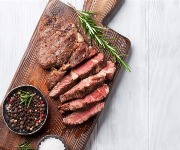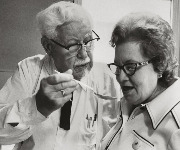How to start your own restaurant (with little money and no plan)

Want to start your own restaurant? Lovefood went to visit chef Philip Dundas in his pop-up dining space in an old garage to find out how to do it.
‘Pop-up’ restaurants are very hip and on-trend now. Though I suspect outside London the phenomenon is still viewed with some suspicion. Perhaps rightly so. From the early days of innocence – a supper with strangers at a table in someone’s front room – to today, when everywhere you turn someone has jumped on the pop-up bandwagon. You may remember the notorious £250 dinner from Thomas Keller of The French Laundry at his Selfridges 10 day pop-up last year and you can still catch Simon Rogan of L’Encume at his two ear ‘pop-up’ restaurant in London’s Marylebone.
But you shouldn’t be put off by the fact that successful restaurateurs have recognised the value that a pop-up venture can add to their brand. You don’t need a department store or kitted out restaurant to give it a go. We were inspired to set up the PipsDish pop-up in an old car repair workshop in Islington, precisely because it was a blank slate we could play with. No one was expecting that.
Pop in to the pop-up
 In a sense, pop-up is just another term to describe the pioneering attitude that characterises smart business thinking. And this way of doing business does offer a real opportunity for an enterprising person to test out the blueprint of an idea before going the whole distance in terms of investment. Let’s face it; lots of people can cook but only a few have what it takes to create a successful and lasting restaurant. Every week someone comes into our garage, proclaiming passion for cooking. And every week I explain that in real terms, I only spend a small proportion of my time actually cooking dishes. Mostly I’m doing the endless paperwork for my accountant or the local council, climbing up ladders to fix the lights, or down below unblocking drains.
In a sense, pop-up is just another term to describe the pioneering attitude that characterises smart business thinking. And this way of doing business does offer a real opportunity for an enterprising person to test out the blueprint of an idea before going the whole distance in terms of investment. Let’s face it; lots of people can cook but only a few have what it takes to create a successful and lasting restaurant. Every week someone comes into our garage, proclaiming passion for cooking. And every week I explain that in real terms, I only spend a small proportion of my time actually cooking dishes. Mostly I’m doing the endless paperwork for my accountant or the local council, climbing up ladders to fix the lights, or down below unblocking drains.
Learning on the job
Not that it’s all HMRC, DIY and HACCP. Of course it’s a thrilling and rewarding challenge to create your own business. The immediacy and learning curve of starting a pop-up is the ideal opportunity for anyone, anywhere to build their skills in all sorts of areas. So, armed with a healthy dose of realism, huge quantities of enthusiasm and a love of ingredients and people, it’s time to find yourself a site where you can test out your concept.
Finding the space
 For me, it all started with the old car I inherited from my dad. One day I took it to the garage to get serviced and the owner told me he was closing and had sold the site. A few days later I started thinking about the space and approached the developer. He was prepared to let it to me on a temporary lease for a reasonable rent.
For me, it all started with the old car I inherited from my dad. One day I took it to the garage to get serviced and the owner told me he was closing and had sold the site. A few days later I started thinking about the space and approached the developer. He was prepared to let it to me on a temporary lease for a reasonable rent.
Finding the right spot for what you want to do is important. If your business will rely on walk-ups or lunchtime footfall for coffee, cake and sandwiches, you need somewhere that will instantly attract people. I knew my customers would be mostly night-time advance bookings so in a way it was an advantage to be a bit of a surprising secret, hidden away behind the main drag.
Get the community on your side
Next, talk to your neighbours. Explain what you want to do and put their minds at ease. The last thing you want is people moaning to the planning department before you’ve had a chance to make your case. We were very lucky to get lots of local support, though the council are still scratching their heads with us as we are technically a garage. However, the environmental health department has passed us with flying colours so, though it’s a bit confusing, they broadly support us. Added to that, we run a project for the elderly from our premises, which gives us some credibility with the local community.
Be prepared to get your hands dirty
I literally spent three weeks steam cleaning, scrubbing, painting and drilling to force the space into some kind of shape as a potential restaurant. Our concept was simple: we wanted to create something like an Italian truck driver’s canteen or a French barn, with trestle tables, chequered tablecloths and great home cooking made from Britain’s best produce. We knew our suppliers really well and I had a small following of fans for my book Cooking without Recipes and the supperclub I had hosted in my house. I’d saved some money to invest in the basic equipment necessary, most of which came from scrapyards and eBay or was begged and borrowed from friends. The idea was that, as we started feeding people, we’d get some revenue in to improve as we went.
Three months that have lasted a year
 What started as a three month pop-up has lasted over a year. I’ve gone from sole trader to limited company with a business partner and two full-time employees. And we’ve proved to ourselves that people like what we do. There’s no menu and no choice but you can bring your own wine. There's no barrier between the customers and the kitchen, we don’t wear whites and it’s completely informal –but we’ve concentrated on making sure that the service and the food are top notch. So people almost always go away happy and with a plan to return. And they often do so with bigger groups of friends.
What started as a three month pop-up has lasted over a year. I’ve gone from sole trader to limited company with a business partner and two full-time employees. And we’ve proved to ourselves that people like what we do. There’s no menu and no choice but you can bring your own wine. There's no barrier between the customers and the kitchen, we don’t wear whites and it’s completely informal –but we’ve concentrated on making sure that the service and the food are top notch. So people almost always go away happy and with a plan to return. And they often do so with bigger groups of friends.
Creative energy and imagination
If you are prepared to learn on the job, then a pop-up could be the way to go. It’s never going to be plain sailing and all the challenges of staffing, suppliers, food safety and overheads are just the same. But for those with the creative energy and imagination to see the potential in somewhere unusual and the resourcefulness to put a great food offer together, the pleasure is even greater in the knowledge you won’t have ten years of investment to pay off. And if it doesn’t work, then you’ll learn the lessons without having to re-mortgage your home.
Fancy some more?
How to get the best seat in a restaurant
12 dinner party table tips from a restaurant pro
Top five restaurants which grow their own
MasterChef winners – where are they now?
Avoid this super-trendy restaurant con
Most Recent
Comments
Be the first to comment
Do you want to comment on this article? You need to be signed in for this feature








